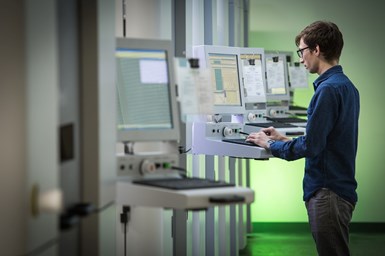Protolabs’ Vapor Smoothing Produces 3D Printed Parts With Enhanced Surface Finish
Process gives users all the advantages of additive manufacturing for parts while still achieving a surface finish that is comparable to injection molding.
Share
Read Next

Following production of the parts using selective laser sintering (SLS) or multi jet fusion (MJF), the team at Protolabs transfers the parts into a smoothing chamber which heats them and introduces a finishing agent. Photo Credit: Protolabs
Protolabs’ vapor smoothing process for 3D printed parts is an automated postprocessing technology designed to further enhance a plastic part’s surface finish on even the most complex geometries in additive manufacturing (AM). The process is currently available for the commonly used nylon material PA-12 as well as the elastic material TPU-01.
The company developed vapor smoothing to bridge the gap for additively manufactured parts to smooth and seal even the smallest cavities on the surface. According to the company, this enables AM parts to be used for a wider range of applications that demand a very fine smooth finish for aesthetic and functional reasons.
The process is also said to improve a part’s mechanical properties with increased elongation at break and impact strength, while the sealed and smoother surfaces are also water and airtight, and easier to clean.
Following production of the parts using selective laser sintering (SLS) or Multi Jet Fusion (MJF), the team at Protolabs transfers the parts into a smoothing chamber which heats them and introduces a finishing agent. Under carefully controlled conditions, this agent evaporates and the vapor spreads across all surfaces of the part. This causes them to melt, liquify and redistribute material to even out any peaks and troughs and seal even the smallest cavity.
Because the finishing process is automated, it can be used for more geometries than a manual smoothing process, which can be limited due to reaching difficult-to-access areas, the company says. This means that users can have all the advantages of AM for parts and achieve a surface finish that is comparable to injection molding, the company says.
Improved water tightness also opens up a number of applications, including tanks, fluid bearing pipes and ducts, valve covers and oil sumps. The medical sector and other industrial applications can also benefit from ease of cleaning due to a smoother surface.
Related Content
-
3D Printed Cutting Tool for Large Transmission Part: The Cool Parts Show Bonus
A boring tool that was once 30 kg challenged the performance of the machining center using it. The replacement tool is 11.5 kg, and more efficient as well, thanks to generative design.
-
AM 101: What Is Hot Isostatic Pressing (HIP)? (Includes Video)
Hot isostatic pressing has long been used for metal castings, but is now being applied as a valuable method for closing porosity in metal 3D printed parts.
-
Postprocessing Steps and Costs for Metal 3D Printing
When your metal part is done 3D printing, you just pull it out of the machine and start using it, right? Not exactly.














